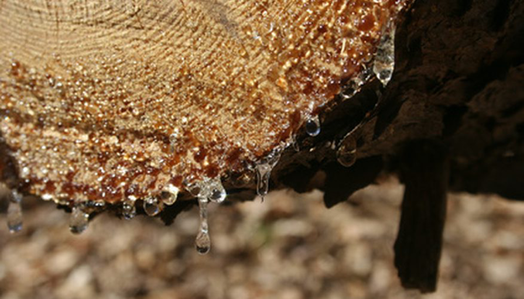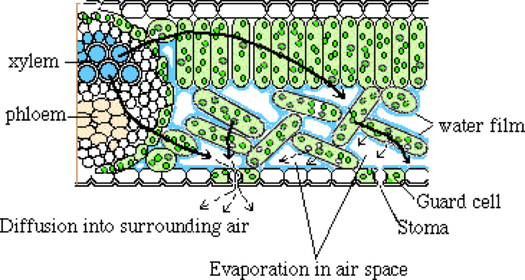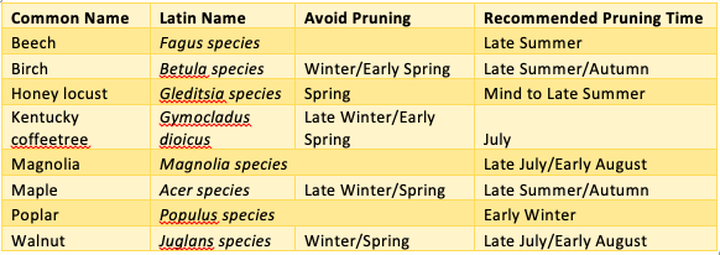If you prune me do I bleed?
|
Authored by Alaina Kapla
|
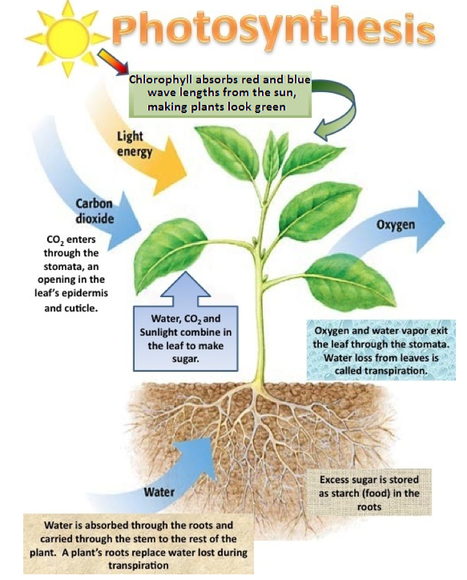 Figure 1. models how plants make sugar and circulate water (2).
Figure 1. models how plants make sugar and circulate water (2).
There’s a misconception surrounding tree pruning that it is unhealthy to prune trees in the spring because they will bleed. When humans are wounded, we worry that excessive bleeding can lead to death. It is tempting to extend this perception to trees and believe that when trees bleed when they are pruned or wounded, they can die (1). Trees are always at work photosynthesizing to make more sugars and absorbing water and nutrients from the soil. Figure 1 illustrates photosynthesis and water uptake in a plant. While humans have a limited amount of blood, trees have a very extensive supply of water and nutrients that do not run dry quickly and allow the tree to stay healthy even when wounded.
There are some tree species that bleed more than others; one of these species is the maple tree. In the spring, maples tend to bleed sap heavily. An entire industry has been built around this trait of maple trees; the maple sap can be collected and boiled to make maple syrup (3). The popularity of this product could be a reason why many people are aware that trees bleed, but don’t understand the process or effects of tree wounding and bleeding.
To better understand the impact of trees that “bleed”, we will dive deeper into the basics of sap flow, wounding, and pruning methods and recommendations.
There are some tree species that bleed more than others; one of these species is the maple tree. In the spring, maples tend to bleed sap heavily. An entire industry has been built around this trait of maple trees; the maple sap can be collected and boiled to make maple syrup (3). The popularity of this product could be a reason why many people are aware that trees bleed, but don’t understand the process or effects of tree wounding and bleeding.
To better understand the impact of trees that “bleed”, we will dive deeper into the basics of sap flow, wounding, and pruning methods and recommendations.
Basics of sap flow: what is bleeding
Water and nutrients are carried through the tree by xylem and phloem; the solution of water and nutrients is called sap. When you prune a tree and cut into this tissue, the sap carried by the xylem and phloem, will ooze out from the tree; this has come to be known as bleeding. Figure 2 is an example of what bleeding may look like.
The way that sap moves through the tree is through transpiration and osmosis. Osmosis moves water from an area of high concentration to an area of low concentration through a semipermeable membrane (5). This is how water enters the roots. From there, transpiration is the driving force of water movement through the tree. Transpiration is the process that carries moisture from the roots up to the leaves where the water turns to vapor and exits through the stomata (6). Figure 3 helps explain transpiration in a leaf.
All trees bleed when wounded, but some species, such as maples, are a little bit different. Spring bleeding in maples is not caused by root pressure because unlike most trees, the pressure in the roots is lower than the pressure in the stem. Increased sap flow in maples is due stem pressure (5). Stem pressure is due to the cycle of freezing and thawing. In the spring, when sap flows the most, night temperatures drop below freezing while day temperatures rise above freezing. At night when the temperature is below freezing, the sap flow will cease, and in the morning when it warms up, the sap begins to flow again (3). This causes a heavier flow of sap, and when the tree is wounded the sap flows quickly outside of the tree to an area of lower pressure.
The way that sap moves through the tree is through transpiration and osmosis. Osmosis moves water from an area of high concentration to an area of low concentration through a semipermeable membrane (5). This is how water enters the roots. From there, transpiration is the driving force of water movement through the tree. Transpiration is the process that carries moisture from the roots up to the leaves where the water turns to vapor and exits through the stomata (6). Figure 3 helps explain transpiration in a leaf.
All trees bleed when wounded, but some species, such as maples, are a little bit different. Spring bleeding in maples is not caused by root pressure because unlike most trees, the pressure in the roots is lower than the pressure in the stem. Increased sap flow in maples is due stem pressure (5). Stem pressure is due to the cycle of freezing and thawing. In the spring, when sap flows the most, night temperatures drop below freezing while day temperatures rise above freezing. At night when the temperature is below freezing, the sap flow will cease, and in the morning when it warms up, the sap begins to flow again (3). This causes a heavier flow of sap, and when the tree is wounded the sap flows quickly outside of the tree to an area of lower pressure.
Wounding
Trees can be wounded in many ways: fire, storm damage, birds, equipment or vehicles hitting the tree, people pruning branches –yes, pruning branches is actually a kind of wound (8). If the wound goes past the bark and damages the cambium layer, the layer of active growth, then the tree will “bleed” because the xylem has been pierced. If the tree is healthy, then new cells will grow over the wound and the tree will recover. Sometimes a wound like this can be a gateway for bacteria and disease to enter the tree. This can cause discoloration of wood, decay, or even death (9). Trees are very resilient and have developed ways to protect themselves from damages like this, for example the walls of CODIT. To learn about the walls of CODIT and wounding, take a look at Nick’s page.
Pruning recommendations
There are many reasons to prune your tree (10):
As mentioned earlier, some trees are more susceptible to bleeding when they are pruned, such as maples, birches, and walnuts. Although this bleeding isn’t harmful to the tree, some people find it undesirable. Table 1. below recommends the best time of the year to prune your tree species to reduce bleeding. Keep in mind that these are general guidelines and not necessarily strict rules to follow.
- maintaining the health of the tree by pruning away dead or diseased branches
- to provide clearance from utility structures and buildings
- aesthetics and to improve the appearance of the tree
As mentioned earlier, some trees are more susceptible to bleeding when they are pruned, such as maples, birches, and walnuts. Although this bleeding isn’t harmful to the tree, some people find it undesirable. Table 1. below recommends the best time of the year to prune your tree species to reduce bleeding. Keep in mind that these are general guidelines and not necessarily strict rules to follow.
Proper pruning methods
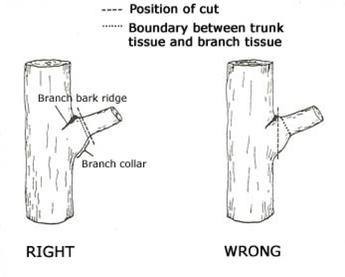 Figure 4. shows where to cut a branch to avoid the branch collar (12)
Figure 4. shows where to cut a branch to avoid the branch collar (12)
When pruning your tree branches, you want to make sure you are cutting outside of the branch collar. The branch collar is where the branch connects to the trunk and an area that contains both trunk and branch meristematic tissue. If you cut into the branch collar, you risk disease entering both the branch tissue and trunk tissue. Disease that enters the trunk tissue can lead to defects throughout the entire tree (10). Figure 4 below illustrates how to avoid the branch collar when pruning. If you are uncertain about when or how to properly prune your tree, consider hiring a certified arborist for professional help.
Overall, pruning your trees is healthy and necessary. Bleeding is a normal response to this kind of damage and is not harmful to the tree. To avoid heavy bleeding, avoid pruning in late winter or early spring when new growth is initiated.
Works Cited
1. Trees Bleeding. Patch, Derek.2004, Arboriculture Advisory and Information Service , pp. 1-8.
2. Botany. Quora.[Online] https://www.google.com/url?sa=i&rct=j&q=&esrc=s&source=images&cd=&cad=rja&uact=8&ved=2ahUKEwidp4n-ufPeAhUEMqwKHRuSCSUQjRx6BAgBEAU&url=https%3A%2F%2Fwww.quora.com%2FBotany-How-do-the-roots-of-trees-get-nutrition-for-themselves-to-grow-Do-they-get-any-nutrition-from-leaves&psig=AOvVaw2v2IiQywoKOXUMmA5WlVkb&ust=1543369604712565.
3. Saupe, Stephen G. Biology of Maple Sap Flow. [Online] St. Benedict/St. John's University, 2009. http://employees.csbsju.edu/ssaupe/biol327/lab/maple/maple-sap.htm.
4. Wiley, Suzanne S. Why Is Sa[ Flowing After a Tree Trimming? Garden Guides. [Online] September 21, 2017. https://www.gardenguides.com/about_7231271_sap-flowing-after-tree-trimming_.html.
5. Pallardy, Stephen G. Physiology of Wood Plants 3rd Edition. 2008. pp. 309-310.
6. Perlman, Howard. Transpiration - The Water Cycle. USGS. [Online] December 2, 2016. https://water.usgs.gov/edu/watercycletranspiration.html.
7. Plant Transport Mechanisms. Earthlink. [Online] 2002. http://home.earthlink.net/~dayvdanls/plant_transport.html.
8. The Morton Arboretum. Trunk wounds and decay. The Morton Arboretum. [Online] 2018. http://www.mortonarb.org/trees-plants/tree-and-plant-advice/horticulture-care/trunk-wounds-and-decay.
9. Forest Service U.S. Department of Agriculture. A tree hurts, too. s.l. : Northeastern Area, State and Private Forestry.
10. Gilman, Edward F. and Lilly, Sharon J. Tree Pruning. Champaign : International Society of Arboriculture, 2008.
11. Brown, G. E. The Pruning of Trees, Shrubs and Conifers. London : Faber and Faber, 1977.
12. Landscape Plants. University of Florida. [Online] 2015. https://hort.ifas.ufl.edu/woody/nursery-pruning-cuts1.shtml.
2. Botany. Quora.[Online] https://www.google.com/url?sa=i&rct=j&q=&esrc=s&source=images&cd=&cad=rja&uact=8&ved=2ahUKEwidp4n-ufPeAhUEMqwKHRuSCSUQjRx6BAgBEAU&url=https%3A%2F%2Fwww.quora.com%2FBotany-How-do-the-roots-of-trees-get-nutrition-for-themselves-to-grow-Do-they-get-any-nutrition-from-leaves&psig=AOvVaw2v2IiQywoKOXUMmA5WlVkb&ust=1543369604712565.
3. Saupe, Stephen G. Biology of Maple Sap Flow. [Online] St. Benedict/St. John's University, 2009. http://employees.csbsju.edu/ssaupe/biol327/lab/maple/maple-sap.htm.
4. Wiley, Suzanne S. Why Is Sa[ Flowing After a Tree Trimming? Garden Guides. [Online] September 21, 2017. https://www.gardenguides.com/about_7231271_sap-flowing-after-tree-trimming_.html.
5. Pallardy, Stephen G. Physiology of Wood Plants 3rd Edition. 2008. pp. 309-310.
6. Perlman, Howard. Transpiration - The Water Cycle. USGS. [Online] December 2, 2016. https://water.usgs.gov/edu/watercycletranspiration.html.
7. Plant Transport Mechanisms. Earthlink. [Online] 2002. http://home.earthlink.net/~dayvdanls/plant_transport.html.
8. The Morton Arboretum. Trunk wounds and decay. The Morton Arboretum. [Online] 2018. http://www.mortonarb.org/trees-plants/tree-and-plant-advice/horticulture-care/trunk-wounds-and-decay.
9. Forest Service U.S. Department of Agriculture. A tree hurts, too. s.l. : Northeastern Area, State and Private Forestry.
10. Gilman, Edward F. and Lilly, Sharon J. Tree Pruning. Champaign : International Society of Arboriculture, 2008.
11. Brown, G. E. The Pruning of Trees, Shrubs and Conifers. London : Faber and Faber, 1977.
12. Landscape Plants. University of Florida. [Online] 2015. https://hort.ifas.ufl.edu/woody/nursery-pruning-cuts1.shtml.
